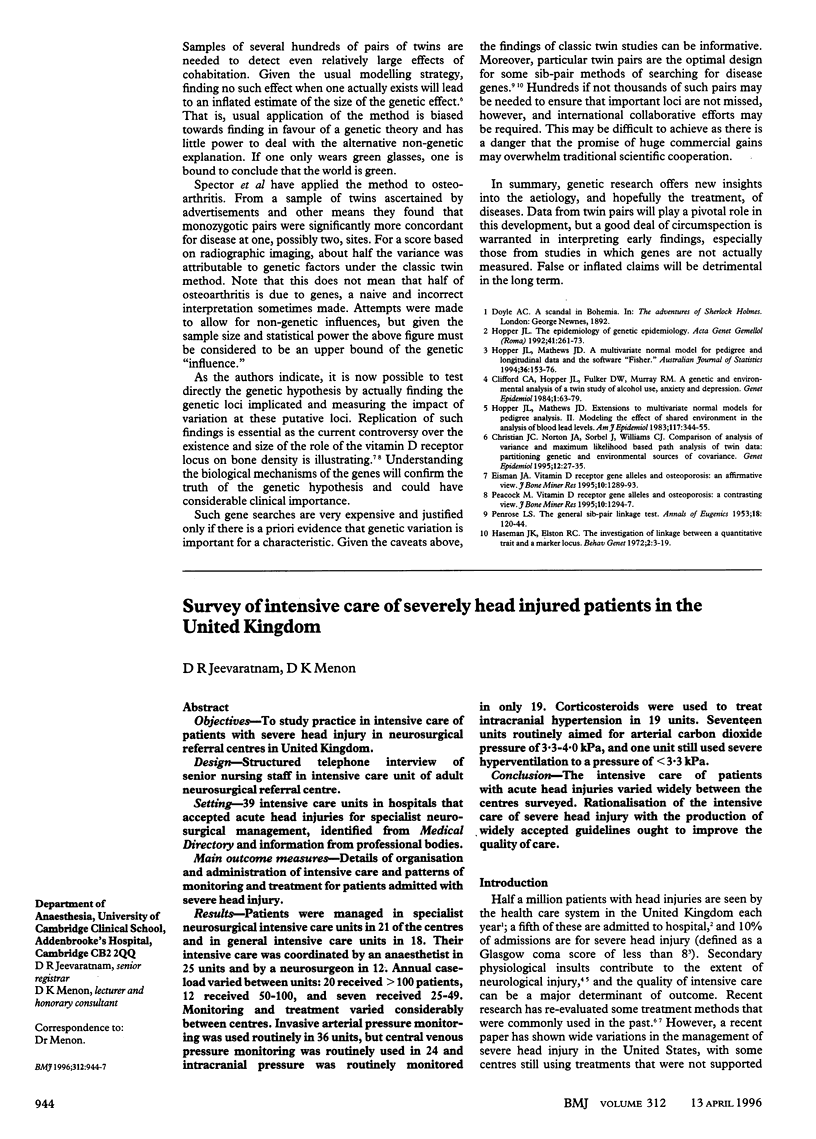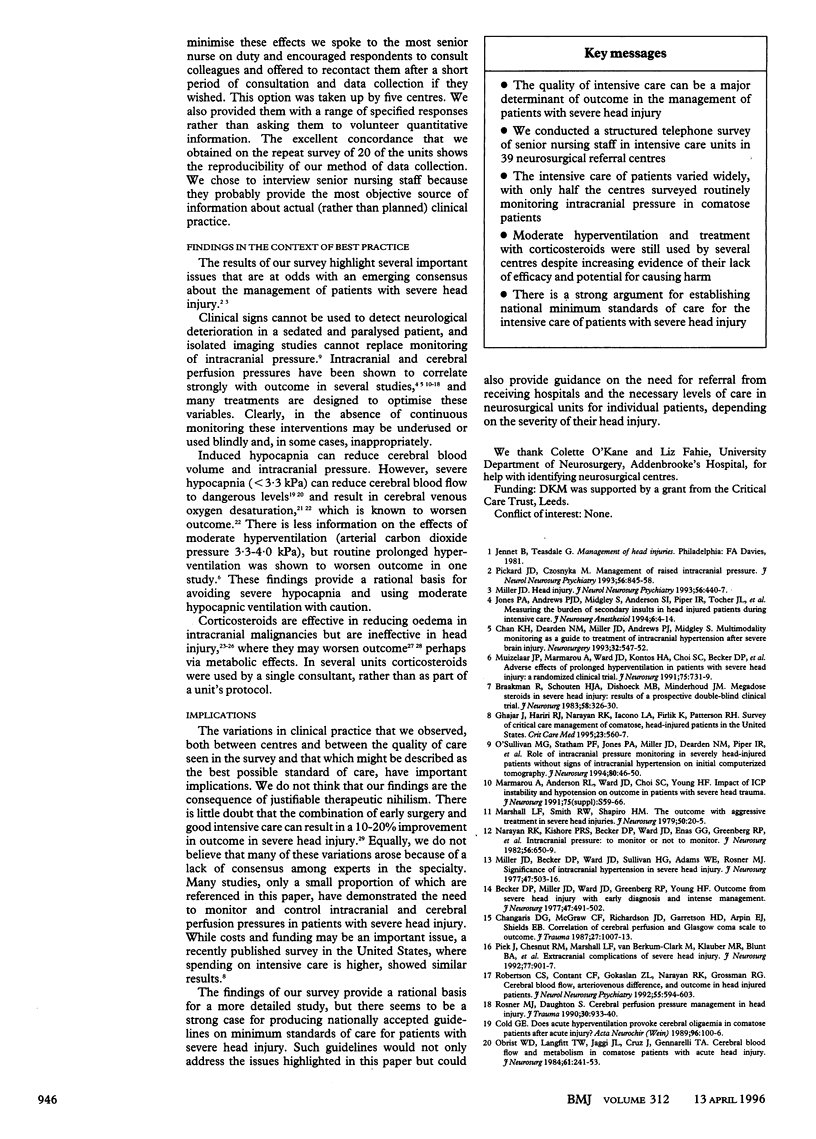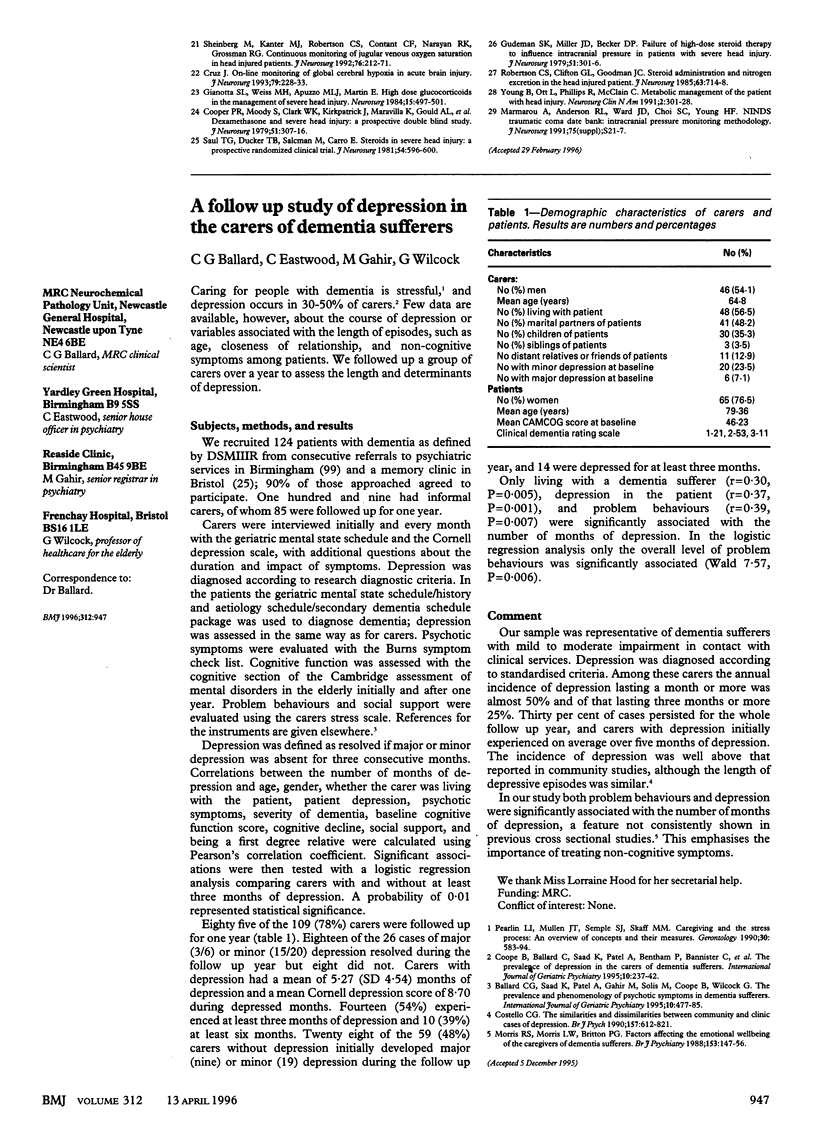Abstract
OBJECTIVES--To study practice in intensive care of patients with severe head injury in neurosurgical referral centres in United Kingdom. DESIGN--Structured telephone interview of senior nursing staff in intensive care unit of adult neurosurgical referral centre. SETTING--39 intensive care units in hospitals that accepted acute head injuries for specialist neurosurgical management, identified from Medical Directory and information from professional bodies. MAIN OUTCOME MEASURES--Details of organisation and administration of intensive care and patterns of monitoring and treatment for patients admitted with severe head injury. RESULTS--Patients were managed in specialist neurosurgical intensive care units in 21 of the centres and in general intensive care units in 18. Their intensive care was coordinated by an anaesthetist in 25 units and by a neurosurgeon in 12. Annual case-load varied between units: 20 received > 100 patients, 12 received 50-100, and seven received 25-49. Monitoring and treatment varied considerably between centres. Invasive arterial pressure monitoring was used routinely in 36 units, but central venous pressure monitoring was routinely used in 24 and intracranial pressure was routinely monitored in only 19. Corticosteroids were used to treat intracranial hypertension in 19 units. Seventeen units routinely aimed for arterial carbon dioxide pressure of 3.3-4.0 kPa, and one unit still used severe hyperventilation to a pressure of < 3.3 kPa. CONCLUSION--The intensive care of patients with acute head injuries varied widely between the centres surveyed. Rationalisation of the intensive care of severe head injury with the production of widely accepted guidelines ought to improve the quality of care.
Full text
PDF



Selected References
These references are in PubMed. This may not be the complete list of references from this article.
- Becker D. P., Miller J. D., Ward J. D., Greenberg R. P., Young H. F., Sakalas R. The outcome from severe head injury with early diagnosis and intensive management. J Neurosurg. 1977 Oct;47(4):491–502. doi: 10.3171/jns.1977.47.4.0491. [DOI] [PubMed] [Google Scholar]
- Braakman R., Schouten H. J., Blaauw-van Dishoeck M., Minderhoud J. M. Megadose steroids in severe head injury. Results of a prospective double-blind clinical trial. J Neurosurg. 1983 Mar;58(3):326–330. doi: 10.3171/jns.1983.58.3.0326. [DOI] [PubMed] [Google Scholar]
- Chan K. H., Dearden N. M., Miller J. D., Andrews P. J., Midgley S. Multimodality monitoring as a guide to treatment of intracranial hypertension after severe brain injury. Neurosurgery. 1993 Apr;32(4):547–553. doi: 10.1227/00006123-199304000-00009. [DOI] [PubMed] [Google Scholar]
- Changaris D. G., McGraw C. P., Richardson J. D., Garretson H. D., Arpin E. J., Shields C. B. Correlation of cerebral perfusion pressure and Glasgow Coma Scale to outcome. J Trauma. 1987 Sep;27(9):1007–1013. doi: 10.1097/00005373-198709000-00009. [DOI] [PubMed] [Google Scholar]
- Cold G. E. Does acute hyperventilation provoke cerebral oligaemia in comatose patients after acute head injury? Acta Neurochir (Wien) 1989;96(3-4):100–106. doi: 10.1007/BF01456166. [DOI] [PubMed] [Google Scholar]
- Cooper P. R., Moody S., Clark W. K., Kirkpatrick J., Maravilla K., Gould A. L., Drane W. Dexamethasone and severe head injury. A prospective double-blind study. J Neurosurg. 1979 Sep;51(3):307–316. doi: 10.3171/jns.1979.51.3.0307. [DOI] [PubMed] [Google Scholar]
- Cruz J. On-line monitoring of global cerebral hypoxia in acute brain injury. Relationship to intracranial hypertension. J Neurosurg. 1993 Aug;79(2):228–233. doi: 10.3171/jns.1993.79.2.0228. [DOI] [PubMed] [Google Scholar]
- Ghajar J., Hariri R. J., Narayan R. K., Iacono L. A., Firlik K., Patterson R. H. Survey of critical care management of comatose, head-injured patients in the United States. Crit Care Med. 1995 Mar;23(3):560–567. doi: 10.1097/00003246-199503000-00023. [DOI] [PubMed] [Google Scholar]
- Giannotta S. L., Weiss M. H., Apuzzo M. L., Martin E. High dose glucocorticoids in the management of severe head injury. Neurosurgery. 1984 Oct;15(4):497–501. doi: 10.1227/00006123-198410000-00004. [DOI] [PubMed] [Google Scholar]
- Gudeman S. K., Miller J. D., Becker D. P. Failure of high-dose steroid therapy to influence intracranial pressure in patients with severe head injury. J Neurosurg. 1979 Sep;51(3):301–306. doi: 10.3171/jns.1979.51.3.0301. [DOI] [PubMed] [Google Scholar]
- Jones P. A., Andrews P. J., Midgley S., Anderson S. I., Piper I. R., Tocher J. L., Housley A. M., Corrie J. A., Slattery J., Dearden N. M. Measuring the burden of secondary insults in head-injured patients during intensive care. J Neurosurg Anesthesiol. 1994 Jan;6(1):4–14. [PubMed] [Google Scholar]
- Liang B. C., Thornton A. F., Jr, Sandler H. M., Greenberg H. S. Malignant astrocytomas: focal tumor recurrence after focal external beam radiation therapy. J Neurosurg. 1991 Oct;75(4):559–563. doi: 10.3171/jns.1991.75.4.0559. [DOI] [PubMed] [Google Scholar]
- Marshall L. F., Smith R. W., Shapiro H. M. The outcome with aggressive treatment in severe head injuries. Part I: the significance of intracranial pressure monitoring. J Neurosurg. 1979 Jan;50(1):20–25. doi: 10.3171/jns.1979.50.1.0020. [DOI] [PubMed] [Google Scholar]
- Miller J. D., Becker D. P., Ward J. D., Sullivan H. G., Adams W. E., Rosner M. J. Significance of intracranial hypertension in severe head injury. J Neurosurg. 1977 Oct;47(4):503–516. doi: 10.3171/jns.1977.47.4.0503. [DOI] [PubMed] [Google Scholar]
- Muizelaar J. P., Marmarou A., Ward J. D., Kontos H. A., Choi S. C., Becker D. P., Gruemer H., Young H. F. Adverse effects of prolonged hyperventilation in patients with severe head injury: a randomized clinical trial. J Neurosurg. 1991 Nov;75(5):731–739. doi: 10.3171/jns.1991.75.5.0731. [DOI] [PubMed] [Google Scholar]
- Narayan R. K., Kishore P. R., Becker D. P., Ward J. D., Enas G. G., Greenberg R. P., Domingues Da Silva A., Lipper M. H., Choi S. C., Mayhall C. G. Intracranial pressure: to monitor or not to monitor? A review of our experience with severe head injury. J Neurosurg. 1982 May;56(5):650–659. doi: 10.3171/jns.1982.56.5.0650. [DOI] [PubMed] [Google Scholar]
- O'Sullivan M. G., Statham P. F., Jones P. A., Miller J. D., Dearden N. M., Piper I. R., Anderson S. I., Housley A., Andrews P. J., Midgley S. Role of intracranial pressure monitoring in severely head-injured patients without signs of intracranial hypertension on initial computerized tomography. J Neurosurg. 1994 Jan;80(1):46–50. doi: 10.3171/jns.1994.80.1.0046. [DOI] [PubMed] [Google Scholar]
- Obrist W. D., Langfitt T. W., Jaggi J. L., Cruz J., Gennarelli T. A. Cerebral blood flow and metabolism in comatose patients with acute head injury. Relationship to intracranial hypertension. J Neurosurg. 1984 Aug;61(2):241–253. doi: 10.3171/jns.1984.61.2.0241. [DOI] [PubMed] [Google Scholar]
- Pickard J. D., Czosnyka M. Management of raised intracranial pressure. J Neurol Neurosurg Psychiatry. 1993 Aug;56(8):845–858. doi: 10.1136/jnnp.56.8.845. [DOI] [PMC free article] [PubMed] [Google Scholar]
- Piek J., Chesnut R. M., Marshall L. F., van Berkum-Clark M., Klauber M. R., Blunt B. A., Eisenberg H. M., Jane J. A., Marmarou A., Foulkes M. A. Extracranial complications of severe head injury. J Neurosurg. 1992 Dec;77(6):901–907. doi: 10.3171/jns.1992.77.6.0901. [DOI] [PubMed] [Google Scholar]
- Robertson C. S., Clifton G. L., Goodman J. C. Steroid administration and nitrogen excretion in the head-injured patient. J Neurosurg. 1985 Nov;63(5):714–718. doi: 10.3171/jns.1985.63.5.0714. [DOI] [PubMed] [Google Scholar]
- Robertson C. S., Contant C. F., Gokaslan Z. L., Narayan R. K., Grossman R. G. Cerebral blood flow, arteriovenous oxygen difference, and outcome in head injured patients. J Neurol Neurosurg Psychiatry. 1992 Jul;55(7):594–603. doi: 10.1136/jnnp.55.7.594. [DOI] [PMC free article] [PubMed] [Google Scholar]
- Rosner M. J., Daughton S. Cerebral perfusion pressure management in head injury. J Trauma. 1990 Aug;30(8):933–941. doi: 10.1097/00005373-199008000-00001. [DOI] [PubMed] [Google Scholar]
- Saul T. G., Ducker T. B., Salcman M., Carro E. Steroids in severe head injury: A prospective randomized clinical trial. J Neurosurg. 1981 May;54(5):596–600. doi: 10.3171/jns.1981.54.5.0596. [DOI] [PubMed] [Google Scholar]
- Sheinberg M., Kanter M. J., Robertson C. S., Contant C. F., Narayan R. K., Grossman R. G. Continuous monitoring of jugular venous oxygen saturation in head-injured patients. J Neurosurg. 1992 Feb;76(2):212–217. doi: 10.3171/jns.1992.76.2.0212. [DOI] [PubMed] [Google Scholar]
- Young B., Ott L., Phillips R., McClain C. Metabolic management of the patient with head injury. Neurosurg Clin N Am. 1991 Apr;2(2):301–320. [PubMed] [Google Scholar]


